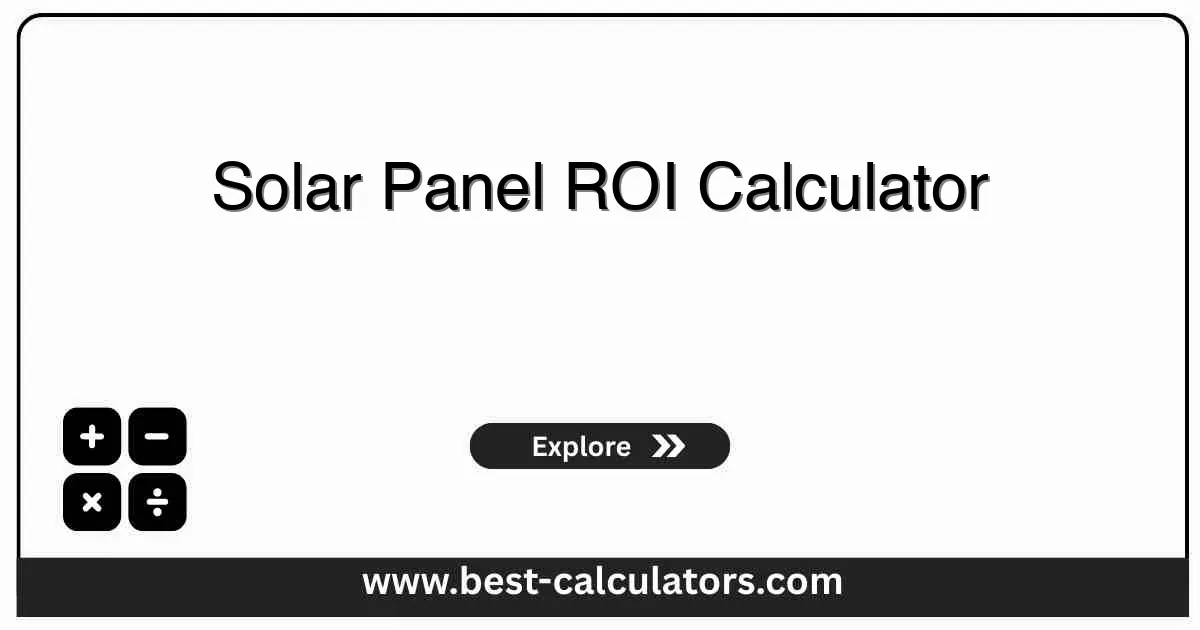Solar Panel ROI Calculator - Calculate Solar Investment Returns
Calculate solar panel return on investment, payback period, and lifetime savings including federal tax credits and local incentives
Solar Panel ROI Calculator
Results
What is Solar Panel ROI?
Solar Panel ROI (Return on Investment) is a financial metric that calculates the profitability of your solar installation. It determines the percentage return you'll earn on your solar investment over its lifetime.
This calculator helps you understand:
- Payback Period - Time to recover your investment
- Lifetime Savings - Total money saved over 25 years
- Annual Returns - Yearly financial benefits
- Environmental Impact - CO2 emissions offset over system lifetime
Maximize Your Green Impact:
Calculate your current carbon footprint with our Carbon Footprint Calculator to see how much your solar panels will reduce your environmental impact.
Track your household water usage with our Water Usage Calculator for comprehensive home efficiency analysis.
How Solar ROI Works
The calculation uses the formula:
Where:
- Net Investment = System Cost - Federal Tax Credit - Local Incentives
- Total Savings = 25-Year Energy Savings - Total Maintenance Costs
- Energy Production = System Size (kW) × Peak Sun Hours × 365 days
- Panel Degradation = 0.5% annual decrease in production efficiency
Key Solar Energy Concepts
System Size (kW)
Total capacity of solar panels, measured in kilowatts. Typical residential systems range from 4-12 kW.
Peak Sun Hours
Average daily hours of optimal sunlight for solar production. Varies by location from 3.5-6.5 hours.
Net Metering
Policy allowing excess solar energy to be sold back to the grid, credited against future usage.
Federal ITC
Investment Tax Credit allowing 30% deduction of solar costs from federal taxes through 2032.
Panel Degradation
Gradual efficiency loss over time, typically 0.5% per year. Quality panels maintain 85%+ efficiency after 25 years.
Inverter
Converts DC power from panels to AC power for home use. String inverters vs microinverters affect cost and performance.
Common Mistakes to Avoid
1. Ignoring Roof Orientation and Shading
South-facing roofs produce 20-30% more energy than east/west. Even partial shading from trees or chimneys can reduce output by 40-80%.
2. Underestimating Maintenance Costs
While minimal, solar systems need periodic cleaning, inverter replacement (~$2000 at year 10-15), and monitoring. Budget $100-300/year.
3. Not Verifying Installer Credentials
Use only NABCEP-certified installers. Poor installation voids warranties and reduces system efficiency by 10-25%.
4. Overlooking Panel Degradation
Solar panels lose ~0.5% efficiency annually. Year 25 production is typically 87% of Year 1. Factor this into savings calculations.
5. Not Considering Future Electricity Needs
Planning to buy an EV or add a pool? Size your system 20-30% larger to account for increased future consumption.
6. Focusing Only on Upfront Cost
Cheap panels may cost less initially but produce 15-20% less energy over their lifetime. Quality matters more than price.
7. Missing Local Incentive Deadlines
State rebates, SREC programs, and utility incentives often have application deadlines or funding caps. Research early!
How to Use This Calculator
Enter System Cost
Total installation cost before incentives (e.g., $25,000)
Set Tax Credits
Federal (30%) and local incentives available
Enter Electric Bill
Current monthly electricity costs
Calculate ROI
Get payback period and lifetime savings
Benefits of Solar Investment
- • Long-term Savings: Eliminate or reduce electricity bills for 25+ years.
- • Tax Benefits: 30% federal tax credit plus local incentives and rebates.
- • Environmental Impact: Reduce carbon footprint and support clean energy.

Frequently Asked Questions (FAQ)
Q: How do I calculate the ROI of solar panels?
A: Solar panel ROI is calculated by dividing the total lifetime savings by the initial investment cost (after incentives). Our calculator considers system cost, energy production, electricity rates, federal tax credits, local incentives, and maintenance costs to provide an accurate ROI calculation.
Q: What is the typical payback period for solar panels?
A: The typical solar panel payback period ranges from 6-10 years, depending on system cost, local electricity rates, sun exposure, and available incentives. Our calculator provides a personalized payback period based on your specific situation.
Q: Are federal tax credits included in the ROI calculation?
A: Yes, our calculator includes the federal solar Investment Tax Credit (ITC), which allows you to deduct 30% of solar installation costs from your federal taxes through 2032. Local incentives and rebates can also be factored into the calculation.
Q: How long do solar panels last and affect ROI?
A: Solar panels typically last 25-30 years with minimal maintenance. Our calculator uses a 25-year analysis period by default, accounting for gradual efficiency degradation (typically 0.5% annually) to provide realistic long-term ROI projections.